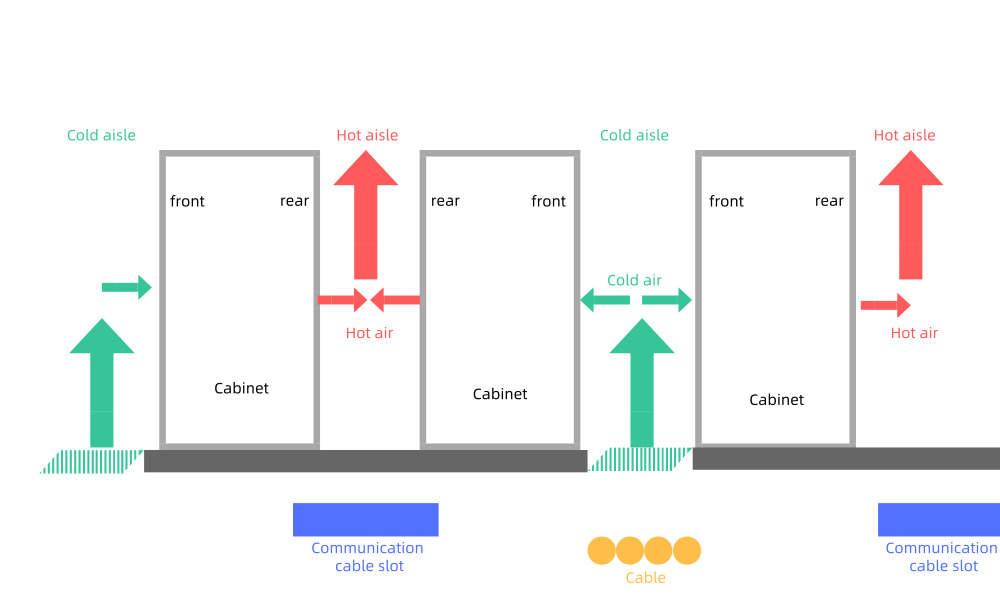
With the increase of data center capacity, the expansion of scale and the introduction of new devices and technologies, servers and key equipment are constantly threatened by excessive temperature.
In the summer, many problems in the data center room followed. The high density of the data center, the full load of the server rack, the air conditioning and airflow organization of the data center, and the unreasonable humidification and dehumidification caused the data center computer room to overheat.
How to cool down the data center? Let’s analyze and solve.
1.Do something when the servers are too hot.
Most data centers are not designed to handle the heat density that many small server cabinets release. There are three potential reasons for this problem:
(1). Your cooling equipment cannot meet the needs of the cabinet;
(2). Your cooling capacity cannot meet the cooling requirements in the room;
(3). Your data center has both of the above reasons.
Solution:
(1). Repair your air conditioning unit or cold air equipment, or increase its power as appropriate.
(2). If your cooling equipment is sufficient, increase the spacing of the equipment or reduce the density of the server, thus reducing the heat density of each cabinet.
2.Air Conditioning Energy Saving Solution
When the cooling capacity of the air conditioner in the data center cannot meet the cooling demand, the common operation is to increase the power appropriately. However, the loss of the electricity cost is amazing when the air conditioning refrigeration degree is lowered by one degree.
Solution:
If you want to meet the cooling requirements of a high-density cabinet above 5KW in a traditional underfloor air supply room, you need to separately install a regional horizontal air supply air conditioning system for some high-power density cabinets. It is recommended to have several high-density systems at the same time. The cabinet is arranged as a hot aisle closed system, which makes the horizontal air supply air conditioner constitutes a high density zone. If it is not possible to install additional air conditioners, and the total air conditioning capacity of the existing air conditioners is sufficient, you can also consider using ADU products, to break through the air supply bottleneck of the floor air outlets.
3.Cold Airflow Organization Optimization
The air conditioning in the data center is to cool the device instead of cooling human. Therefore, it is unreasonable to open the air outlet to try to reduce the temperature of the data center. It will affect the air circulation in the data center and cause more hot spots.

Solution:
The devices and rack in the data center should adopt the installation method of “hot and cold passage”, which improves the utilization rate of the precision air conditioner in the equipment room and further improves the cooling effect.
4.Cabinet Airflow Optimization
Proper layout of the cabinet space is also important to ensure that the cabinet has the proper temperature and adequate cold air. A reasonable cabinet layout goal is to control air circulation, which prevents cold air from mixing with hot air before reaching the equipment intake.
Solutions:
(1) The cabinets can be arranged in rows, using the technology of hot and cold channels, back-to-back layout.
(2) Install the blind plate.
(3) Use standard width cabinets (using ultra-wide cabinets may cause hot air to be short-circuited through the side of the equipment)
(4) Use a deep-expanding cabinet.
(5) Fixing devices with screws (using the tray to install devices will cause the blind position of the relevant position to be uninstallable, thus providing completely open conditions for the short circuit of hot air, which should be avoided as much as possible.)
(6) Use a cabinet with a fan system to deliver the bottom air to the front of the cabinet or actively remove hot air from the rear of the cabinet.
5.Rational Use of Humidification and Dehumidification
In the data center with large energy consumption of adding/dehumidifying, special dehydration/dehumidification devices can be considered;
According to the devices’ specifications: Generally, a humidifier and dehumidifier are arranged for every 80 square meters of space. The technical specifications are 5-9 kg/hour for the humidifier and 3-5 kg/hour for the dehumidifier. Turn on the humidifier when the relative humidity of the equipment room is lower than 20%. Turn on the dehumidifier when the relative humidity is higher than 80%.
If the data center uses a separate humidifier, do not make the humidity higher than the demand, which will cause multiple refrigeration equipment to contradict each other: if the recirculation gas temperatures of the two refrigeration systems are inconsistent, or the humidity sensors of the two devices are inconsistently calibrated, or two The humidity values set by the devices are different. Resisting the operation of the refrigeration system will cause one refrigeration unit to reduce air humidity and the other to increase air humidity. This mode of operation is extremely wasteful of resources and is not easy for the computer room administrator to discover.
The humidity system’s humidity resistance to operational problems can be solved by:
a) use central humidity control;
b) coordinate humidity values between refrigeration equipment;
c) turn off one or more humidifiers in the refrigeration system;
d) use floating value settings. Confirm that the system settings are the same, the calibration is the same, and the floating value setting range is expanded. In general, this problem can be corrected by setting the floating value range to ±5%.
Can those solutions cool down your data center in Summer? Leave your comments!



